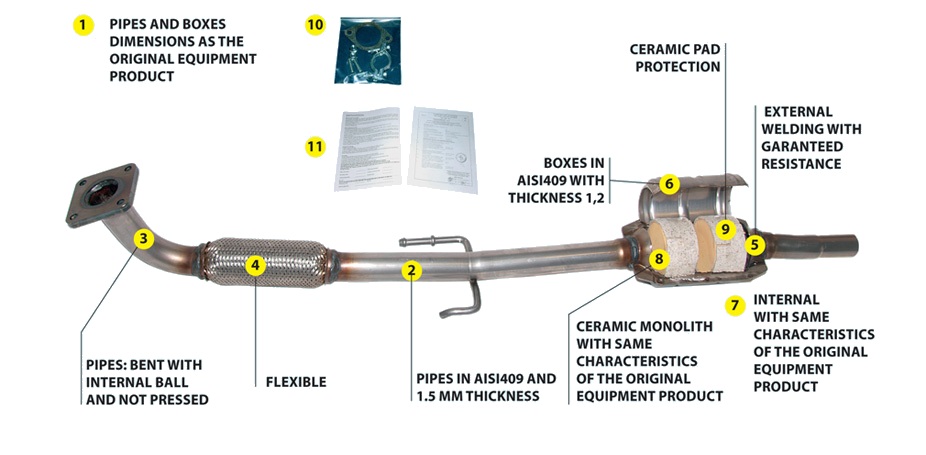Catalitic converter
What is it and how does it work:
The European Community, which is becoming more careful to respect the environment and to limit the toxic issues, obliges the
producers of car to furnish them with catalytic converters. The catalytic converter is a monolith, produced similar to a bees’ honeycomb
structure in order to create a big surface, which is covered by precious metals (such as Platinum, Palladium and Rhodium).
The vehicle exhaust gases, which are of a very high temperature, come in touch with the precious metals within the unit, and they
are subjected to a chemical reaction which oxidizes and reduces the poisonous gases making them less noxious.
Before the replacement:
It is necessary to solve any possible malfunction of the vehicle:
1 wrong electronic regulation or wrong balance between air / fuel
2 delayed or advanced ignition in the engine, faulty lambda sensor, faulty injectors, defective valves which can let unburned fuel
reach the catalyst, inflames itself an burn out the catalytic converter.
3 time-worn engine components which let oil or antifreeze liquid reach the catalytic converter, creating ashes which increase the
back-pressure and reduce the engine power and its life.
4 damaged spark plugs and cables, which can let unburned fuel reach the catalyst, inflames itself an burn out the catalytic converter.
5 damaged oxygen sensor, that send the wrong data to the electronic control unit, with the consequent creation of a wrong mixture
of air / fuel, weather too rich, which would burn out the monolith or too poor that wouldn’t spark the chemical reaction, necessary
to the oxidation of noxious gases.
6 anomalous vibrations, caused by damaged hangers, or received shocks which destroy the monolith, that is made of very thin
and delicate ceramics. The broken ceramics interrupts the gas flow, increasing the back-pressure or comes out from the catalytic
converter leaving it empty.
During the replacement:
1 always use new rubber.
2 put the catalytic converter perfectly in line, to avoid vibrations or abnormal pressures.
3 do not to use metal hammers or other hard tools which could break the monolith
4 as sealant use silicone and not the normal paste for the exhaust system
5 carefully verify the new emissions, to solve immediately eventual problems.
Guarantee:
Are not covered by guarantee all the damages caused by external factors as:
1 monolith braking caused by anomalous vibrations or impacts due to accidents or uneven road surfaces.
2 monoliths burning out, caused by a bad regulation of the engine
3 obstruction of the monolith caused by the use of paste instead of using the correct sealant silicone
4 obstruction of the monolith caused by wrong fuel
5 obstruction of the monolith caused by oil or antifreeze liquid contamination



